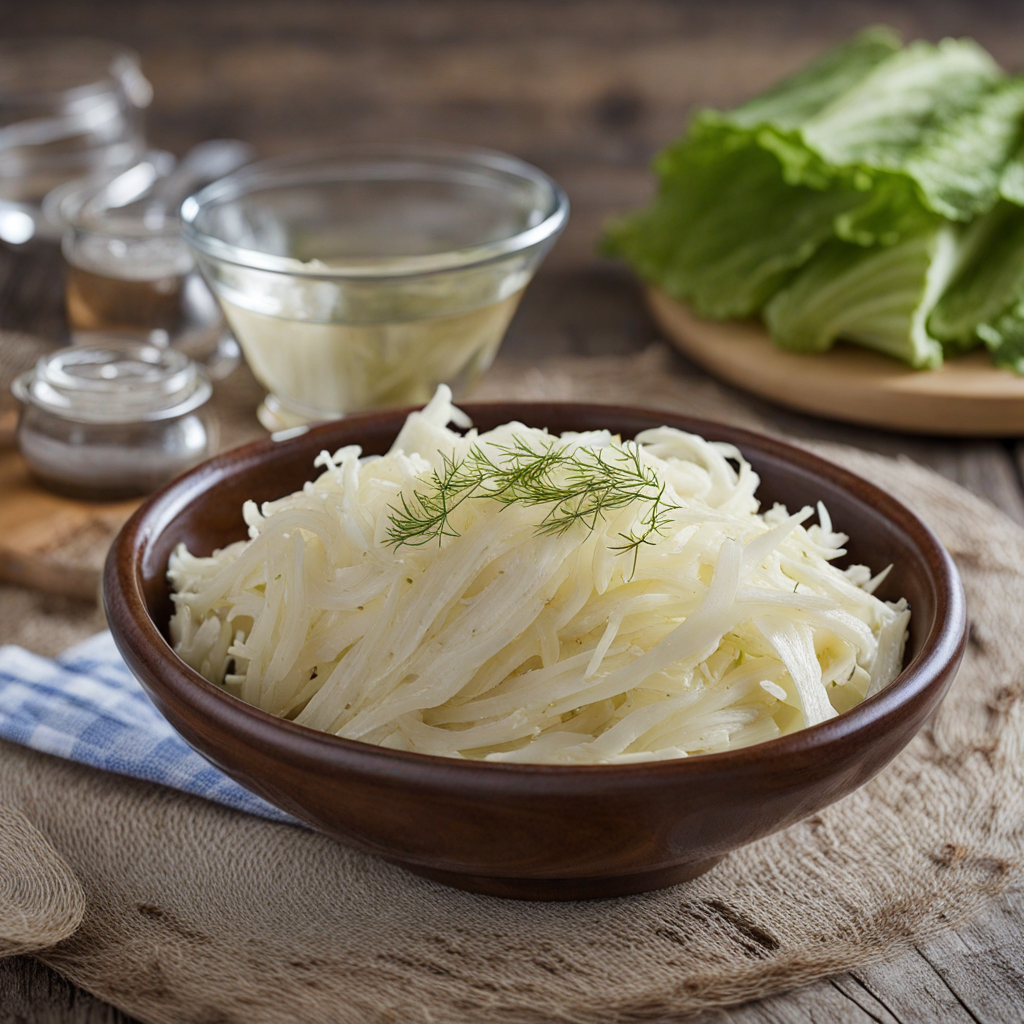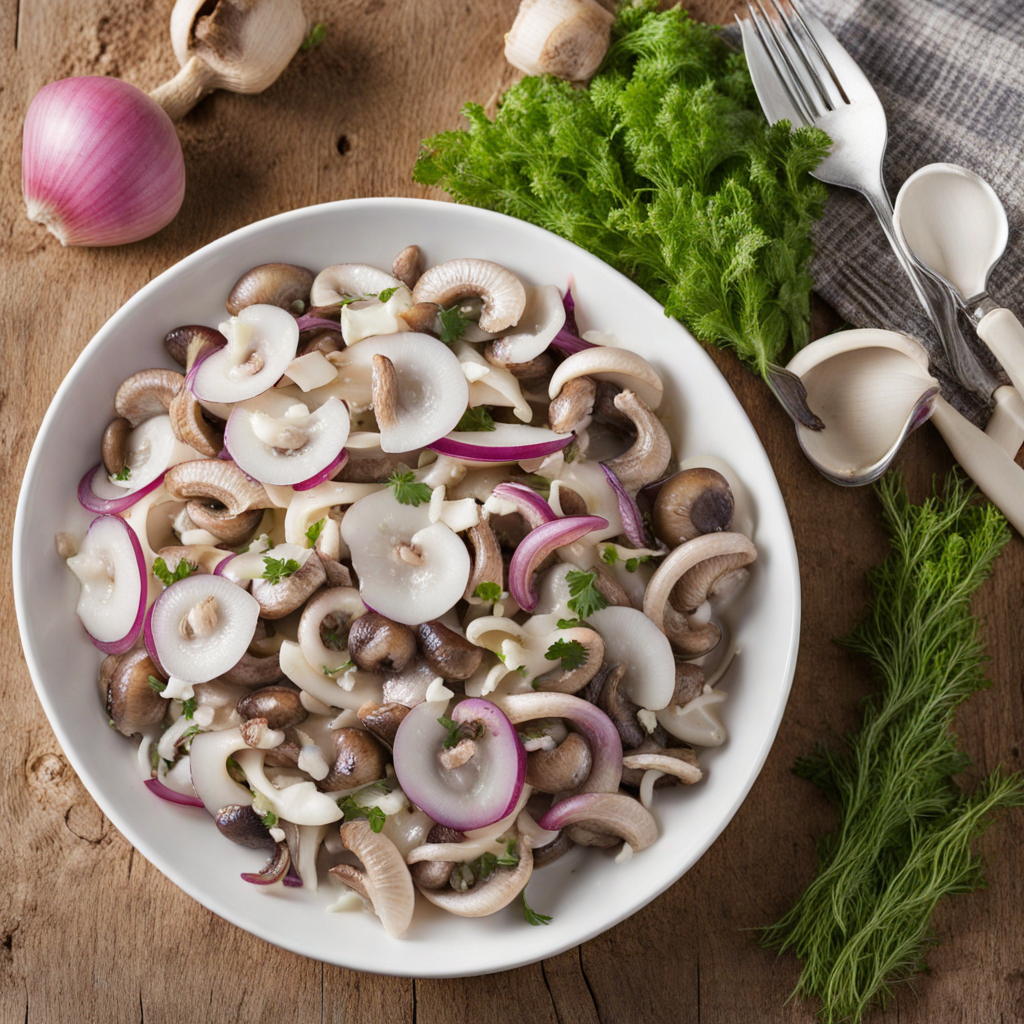Fermented Cabbage
Fermented cabbage, known as 'hapukapsas' in Estonia, is a traditional dish that showcases the art of preserving vegetables through fermentation. This dish consists of finely shredded cabbage that undergoes a natural fermentation process, typically enhanced with salt and sometimes caraway seeds for added flavor. The result is a tangy, slightly sour product that retains the cabbage's crisp texture while developing a depth of flavor that is both refreshing and complex. Estonians often enjoy hapukapsas as a staple accompaniment to various meals, particularly during the colder months, as it provides a nutritious and hearty addition to the diet. The fermentation process not only transforms the cabbage's taste but also enriches it with probiotics, making it a gut-friendly food. The vibrant acidity of hapukapsas can elevate any dish, serving as a perfect counterpoint to richer meats, such as pork or smoked fish. In Estonian cuisine, it is often served alongside hearty dishes, adding a bright burst of flavor that cuts through the richness, making each bite more satisfying. Additionally, it can be enjoyed on its own as a tangy snack or incorporated into salads, offering a delightful crunch and a unique zest that invigorates the palate. In Estonia, hapukapsas is more than just a food item; it represents community and tradition. Families often prepare large batches during the cabbage harvest season, ensuring a stockpile of this delicious fermented treat to last through the winter months. The process of fermentation can vary from household to household, leading to subtle differences in flavor and texture, making each family's hapukapsas uniquely their own. Discovering fermented cabbage is not just about tasting a new dish; it's about experiencing a piece of Estonian heritage that has been cherished for generations.
How It Became This Dish
Hapukapsas: An Engaging Journey Through the History of Estonian Sauerkraut Hapukapsas, or fermented cabbage, is not merely a staple of Estonian cuisine; it is a symbol of resilience, tradition, and cultural identity that has endured through centuries of change. This dish, known for its tangy flavor and crunchy texture, has deep roots in the agricultural practices of Estonia and holds a significant place in the hearts and homes of Estonians. To understand hapukapsas fully, one must explore its origins, cultural significance, and the evolution of this beloved dish through time. #### Origins: A Reflection of Agricultural Practices The origins of hapukapsas can be traced back to the agricultural practices of the Baltic region, where cabbage has been cultivated for centuries. Historical records suggest that cabbage was introduced to the area during the early Middle Ages, likely brought by traders and travelers from central Europe. The cool climate of Estonia proved favorable for growing cabbage, and by the 14th century, it had become a common crop among Estonian farmers. In its most basic form, hapukapsas is made by fermenting finely shredded cabbage with salt and sometimes spices. Fermentation, which utilizes the natural lactic acid bacteria present on the cabbage leaves, was an essential preservation method before the advent of refrigeration. This technique not only allowed for the long-term storage of cabbage but also enhanced its nutritional value, making it a vital food source during the harsh Estonian winters when fresh vegetables were scarce. #### Cultural Significance: The Heart of Estonian Cuisine Hapukapsas is more than just a food item; it is interwoven into the fabric of Estonian culture and identity. The dish has played a central role in traditional Estonian celebrations, especially during the winter months, when families would gather to prepare and enjoy hapukapsas. It is often served alongside roasted meats, particularly pork, and is a key component of festive meals during Christmas and other holidays. The preparation of hapukapsas is often a communal event, where families come together to shred cabbage, mix in the salt, and pack it tightly into fermentation vessels. This process not only fosters a sense of community but also reinforces cultural ties as recipes and techniques are passed down through generations. The act of making hapukapsas is steeped in tradition, with many families boasting their own unique methods and secret ingredients. Moreover, hapukapsas has been historically significant in Estonian folklore and customs. In some regions, it was believed that consuming hapukapsas on New Year’s Day would bring prosperity and good fortune for the coming year. This practice highlights how food can be a vehicle for cultural beliefs and traditions, shaping the way communities celebrate life’s milestones. #### Development Over Time: From Necessity to Culinary Art As Estonia faced various historical challenges, including invasions, occupations, and economic hardships, hapukapsas evolved from a simple preservation method into a cherished culinary art form. The 20th century was a particularly tumultuous time for Estonia, as the nation experienced significant political upheaval and changes in governance. Despite these challenges, the love for hapukapsas remained steadfast. During the Soviet era, traditional Estonian foods, including hapukapsas, were often modified to fit a more standardized and industrialized food system. Cabbage production increased, and the dish became more widely available in canned and jarred forms. While this accessibility helped preserve the tradition of hapukapsas, many purists lamented the loss of the artisanal methods that had characterized its preparation for generations. With Estonia regaining independence in 1991, there was a resurgence of interest in traditional foods, including hapukapsas. This revival was part of a broader movement to reclaim national identity and heritage. Home-canning and artisanal fermentation regained popularity as people sought to reconnect with their roots and preserve traditional methods. Farmers’ markets and food festivals began to showcase local products, and hapukapsas became a symbol of the Estonian culinary renaissance. In contemporary Estonia, hapukapsas continues to hold a special place in everyday life. It is not only served in homes but also features prominently in restaurants, where chefs experiment with modern interpretations while honoring traditional flavors. Variations of hapukapsas can now be found, infused with ingredients such as apples, juniper berries, or even spices from other culinary traditions, reflecting the evolving nature of Estonian cuisine. #### Health Benefits and Modern Trends In addition to its cultural significance, hapukapsas has gained recognition in recent years for its health benefits. The fermentation process enriches the cabbage with probiotics, promoting gut health and digestion. As the global interest in fermented foods continues to grow, hapukapsas has found a place in the diets of health-conscious individuals both in Estonia and abroad. Modern Estonian chefs and food enthusiasts are also embracing the concept of “farm-to-table,” emphasizing the use of locally sourced ingredients in their hapukapsas preparations. This trend not only supports local agriculture but also aligns with a global movement towards sustainable and ethical food practices. #### Conclusion: A Living Tradition Hapukapsas is more than just fermented cabbage; it is a living tradition that has weathered the storms of history and change. It reflects the agricultural roots of Estonia, serves as a conduit for cultural expression, and embodies the resilience of the Estonian people. As we move forward in an increasingly globalized world, hapukapsas remains a testament to the importance of preserving culinary heritage while embracing innovation. Whether enjoyed at a festive gathering, as a comforting side dish, or as part of a modern culinary experience, hapukapsas continues to connect Estonians to their past while nourishing their present. As the world becomes more aware of the value of traditional foods, hapukapsas stands proudly as an emblem of Estonia’s rich gastronomic landscape, a celebration of flavor, culture, and community.
You may like
Discover local flavors from Estonia







